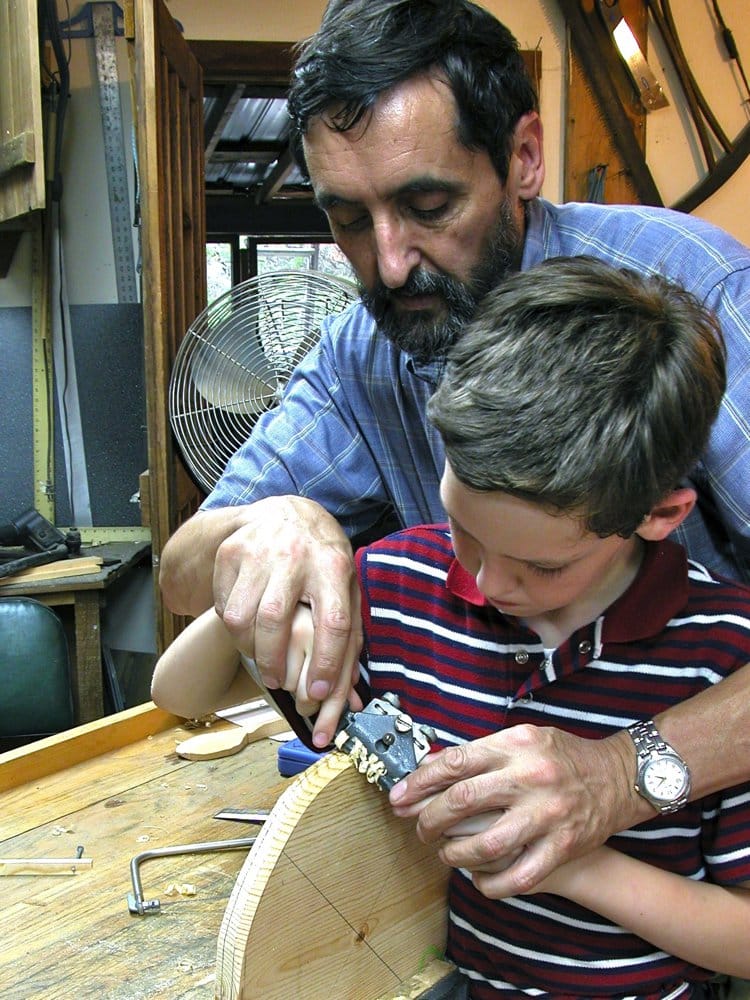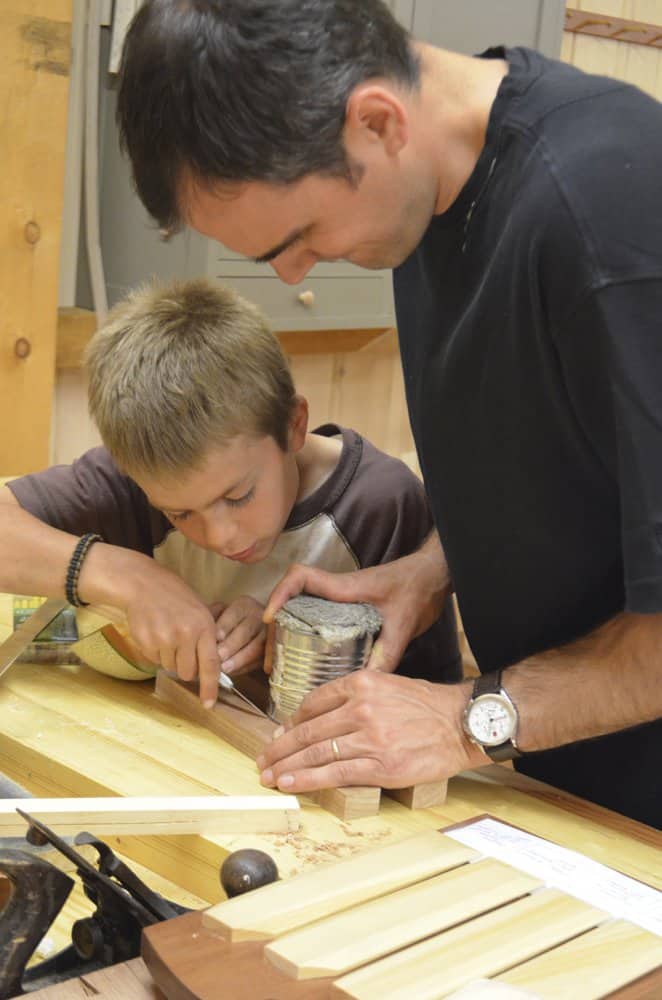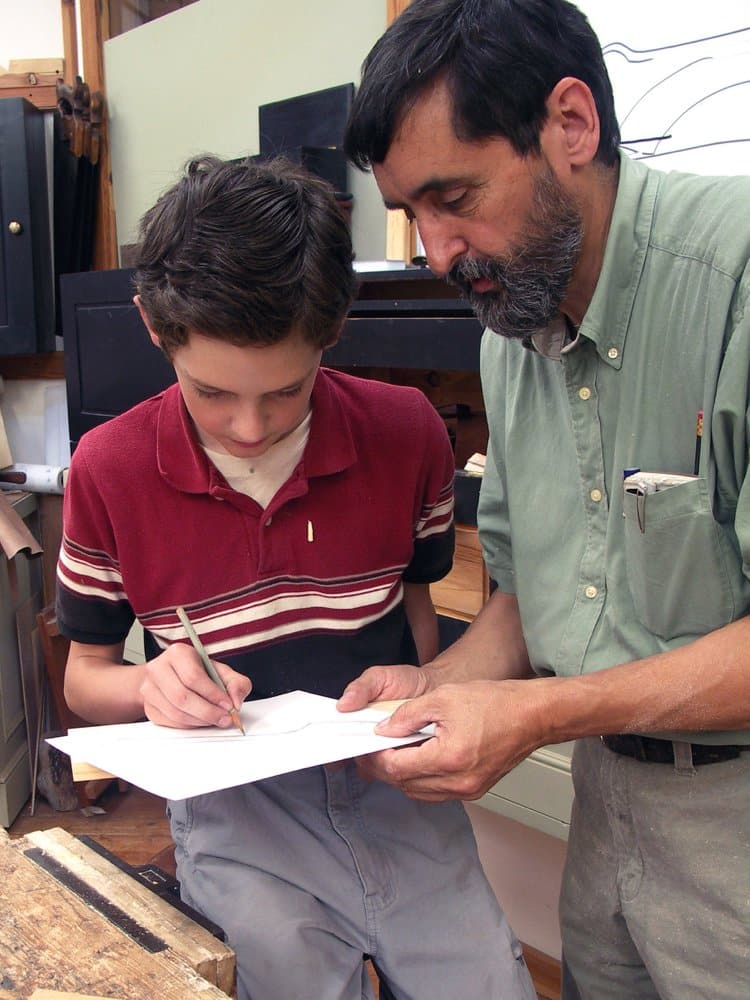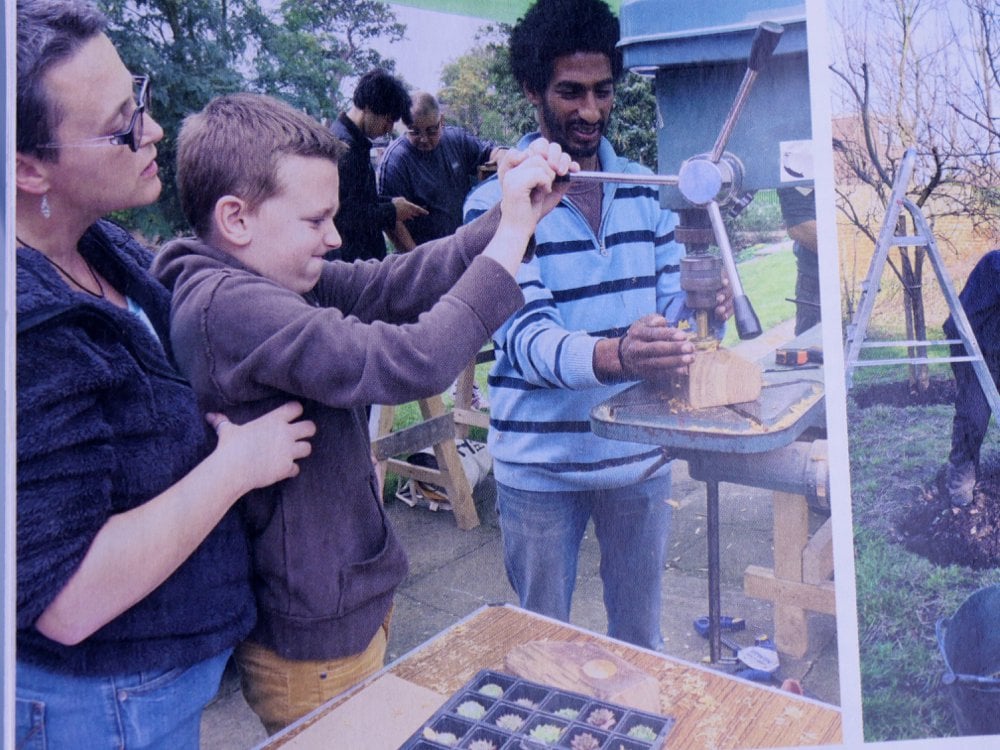Safety for Kids in Woodworking


The ubiquitous pillar drill (drill press USA) seems innocuous when you see it standing there running. It runs quite quietly, you pull a lever, the quill lowers centred in the wood and a hole appears seemingly from nowhere. So what’s wrong with this picture?
First of all I think those of us in the know have a responsibility to raise a red flag no matter who runs the show. This event is being run by the British organisation the National Trust. An organisation well known as a highly responsible organisation within its sphere of expertise. The first impressions are those of children’s fun, experiencing woodworking for the first time, stimulating and inspiring generations and so on. The National Trust is naively involved in the support of something without managing the event from the standpoint of safety because of its, well, ignorance. Most of us could just pick holes in this and of course we all overlook things in our enthusiasm to encourage the next generation, but that does not excuse us from responsibility. Here is the list of issues in the picture above.
1: The child is pulling on the lever to send the drill bit into the wood. He has no experience of pulling and between him and his mother there could pull the whole unit over onto himself and the woman holding him or someone else in the unfenced area he is working in.
2: He has no safety glasses on to protect his eyes.
3: The woman has no safety glasses on.
4: The man supervising has no safety glasses on.
5: Safety shields would be more effective for everyone in this case as the wooden block can be dislodged and fly from the table.
6: The work holding seems adequate if that is indeed a clamp holding the work in the background, but the child is still pulling on the press and the man’s hands are still cupped around the block of wood. Perhaps his hands are to prevent flying bits from hitting the child, but it sends a message saying it’s safe to have your hands in this close proximity, which without having control of the lever becomes a problem.
6: Clamps lying on the ground.
7: Is the child being lifted to task? If so, can there be enough control?
It is a difficult call when you do not want to stymie creativity and touching the palate of our children, but safety and children is often overlooked in our enthusiasm to encourage. It can all seem so innocent and indeed it is. 
I did try contacting the National Trust at Rainham Hall but I found their system difficult as ever to navigate on a local level so I decided that this would actually be a more effective way anyway.



I would love to discover what types of projects and ways of working would be suitable for children and approximately at what age level they can be safely introduced.
The boy’s hooded sweatshirt probably has a dangling drawstring at the neck. The hood itself is “never do” in my books near a rotating machine. At least they aren’t wearing gloves.
Actually, I am surprised how many woodworkers where gloves when using a bandsaw and such. I know some gloves are designed for such things but these are not the ones I am talking about.
I don’t wish to disagree with anything you have said Paul, but I do wonder if the drill is running? The man’s left hand seems to be touching the chuck on the quill, and would give him a burn if it was running fast. Also, I don’t see any clamp on that piece of wood. Maybe they are just centreing the wood prior to starting the machine?
On the other hand, there is some wood chips/swarf lying about, so maybe . . .
_Everything_ wrong with this.
I did try to relate to all possibilities here but looking at the child’s face I think I am right in the body and face language that he is indeed still pulling. It’s not that I want to dis anyone here. Just to say there is no magic bullet that good intentions exempt us from injury. Even with all precautions and safeguards in place and upheld injuries still happen. I hope this will raise awareness that’s all.
My only comment on looking at that picture is: “Yikes!”
I do think you are right about power tools keeping kids out of woodworking. My father at one time was a framing carpenter, but he never passed on those skills because I was never allowed near him and the table saw, circular saw, nail gun, and everything else when he was working on the house. I now wonder what a contrast it would have made if my great-grandfather would have lived another ten years and I could have sat in his shop in the back of the barn watching him work with all those handtools he employed in cabinetmaking during his long lifetime. What a difference in only three generations.
I see so often how power machine woodworkers encourage a culture of validation by their children using such equipment. I realise that it is mostly because they too never mastered the skills with hand tools and sharpening and such. I once saw a ten year old using an 18″ chainsaw with no safety chaps or headgear with his dad encouraging him on.
Clearly a case of the blind leading the blind. You were right to try and raise the safety issues with the NT Paul as they are quite clearly leaving themselves open to prosecution should an accident occur either to a member of the public or that clown of an operating supervisor. Assuming he is the said supervisor of course.
In industry a person has to be over 18 to use dangerous machinery but I’m not sure whether that law would apply in this situation. However, the supervising operator still has to be deemed at the minimum a ‘competent person’, which is a term used so often throughout H&S legislation. Looking at that photograph would raise serious doubts as whether that gentleman is entitled to that honour even though he maybe the owner of a piece of paper obtained from having sat a one or two day course in a NT classroom somewhere.
The NT needs to carefully re-examine their safety policy when holding open days because apart from the H&S covenants they could also fall foul of the Child and Young Persons Act (CYPA) which is equivalent to the Child Endangerment laws in the US. Be warned NT.
Thank you for this blog. It’s is most important that the safety of any person, they must use the proper safety equipment and even more so with children, as you say kids are just to sure unpredictable and will try to get thing done quickly, thank you for all your video’s and hints
The blue and yellow head of the clamp is visible just behind the man’s right hand and the bar of the clamp runs vertically below the table nearly to the ground. On the ground you can see similar blue and yellow clamps.
I do agree though that I think the drill is off and I think the photo is staged. However, even staging a photo portrays how the work should be done and the lack of eye protection and hands near the bit are inexcusable in a setting where only an expert should be instructing rather than what appears to be good intentions and ignorance.
You are right on Paul! This machine operators safety issue is one major reason why wood shop is no longer available in our schools here in the USA. Liability is to great and there are to many sue happy attorney’s ready to sue school systems for the smallest infraction.
Both machine and hand tools can cause harm but adults have the benefit of experience. In my case after many years in the petroleum industry I have been exposed to numerous incident reports from around the world. You learn very quickly when you see some of the photographs. Children of course are (rightly) shielded from these horrific images and with their lack of experience and caution cannot be relied upon to always act safely. Ignoring the legal side of matters because after all once the accident has happened the law cannot repair the damage, the key is constant supervision. Again, ignoring the legal side, the thing to avoid is the agony of having hurt a child, an adult, anyone in fact whilst trying to create something. For me the main message is to eliminate risk. Isolate a machine before altering settings. Clean up before you trip. Roll up your sleeve before it drags you into harms way. Reach for the hammer before using the heel of your hand on a chisel. Fit a handle to a file before driving the tang through your palm. Use extraction before inhaling dust. Use gloves before exposing skin to chemicals. Use ear protection before you go partially deaf, who wants to grow old not being able to hear their grandchild whisper in their ear? Wear eye protection before a trip to the eye hospital. The list goes on and on……….The vast majority of accidents are avoidable, not all, but for children it is so important to remember that us adults have a huge amount of experience and they have none. I have a small workshop downstairs and I simply won’t let children near power tools as they can cause too much damage in so short a time.
I completely agree Paul, keep up the good work.
When I was a supervisor for a rehabilitation woodwork shop, most of the people where young adults or adults with little or no work experience, let alone experience using machinery of any sort. Making an assessment of their ability to use a machine was a major part of my responsibilities.
I would set up the machine and have jigs to safely aid the operation where ever possible. When introducing them to any machine, I would first show where and how to STOP the machine, even before starting it. I would then show how to do the operation explaining as I go how to hold the timber or jig and to lookout for kickback etc. I would then closely monitor them as they did the operation, correcting any fault for a least four or five sequences before leaving them, but often checking back in. Anyone who could not fully understand how to operate the machine where either on tail out or back to the sanding bench. Thankfully there were no serious accidents while i was in charge. The use of push sticks and jigs is a must for even the most experienced woodworker.
Some of the few machines I feel a child (10 +) could “safely” use would be a scroll saw and possibly a bandsaw with the guards set close to the work, as they should be anyway. A drill press, set up better than your example, with the work securely clamped, as it should be anyway (repeating myself) can be used as well. Any machines would need the child standing on a stable platform to a height they can work, with an adult who is fully competent with the operation at their side the whole time. As for using any other machine: OFF LIMITS no exceptions. I’ve seen a chop saw loose part of the alloy fence shearing a 6 mm bolt after a piece of beading jammed the blade. We found the fence over 10 meters away after it whizzed past me; thankfully no blood. Do you really want a 10 year old using a chop saw?
Thirty years ago I was working in my basement shop. I was adjusting my table saw and working close to the blade. I had neglected to pull the plug and the safety key was still in. I did not see my four year old walk in to my shop. She turned the table saw on. I never got hurt but it was a close call.
Three years ago I had just taken up wood working an found my self doing the same thing on my new table saw. I remembered the incident from 30 years ago and said to myself this is stupid. But I continued working because all my kids had grown up and moved out. And just as I was thinking this my next door neighbours five year old kid walked into my shop.
If something can happen it will.
My Goodness that’s shocking! I’ve done a lot of chainsaw work and there is no way in Gods green earth I would let a young child near one. I nearly lost my toes one day when I was limbing a tree. As I was cutting through a branch I didn’t realise that the tip of the saw made contact with a second branch that was concealed from view. When I cut through the first branch the saw ran straight down and hit my boot ran up over my foot and down into the dirt. I had just sharpened the saw. Afterwards I looked at my boot to discover that it would have cut through only for a steel cap in the boot. Chainsaws are a serious bit of kit that are definately not for kids!
“I am surprised how many woodworkers wear gloves when using a bandsaw and such.” There are so many advertisement photos of tools for sale in which people are “doing it right” with gloves on that I think people are getting bad information about when to wear gloves. My machine experience is not extensive, but what experience I do have I learned from machinists that were also woodworkers. Maybe that is the source of my strict avoidance of things that can be drawn into a machine? There was also a kid with long hair in junior high school that had his hair drawn into a drill press in shop. For me, nothing that dangles. Buttoned sleeves. No jewelry. Put your hair up or cut it off.
Ha ha that made me laugh. I know you were being serious but the mental image of someone cutting their hair off in a workshop is pretty extreme.
Hi. My 16 year old just recently acquired a lot of good, brand name woodworking tools such as grinder, sanding belt, mitre and jig saws, etc. I know the obvious hazards, but I am very concerned about the lesser known hazards of wood allergies. He also got, along with the tools, a box of mixed woods such as bocote, zebra, cedar, pine, oak, Purple Heart, etc. He’s basically “playing” so exposure is not in large quantities, but I am very worried about all of the allergy issues I am reading about. Can you shed some light please?
Hello Coleen, It sounds as though he got machines and not tools as such. In my experience most people including woodworkers and even woodworkers with experience seldom know the full extent of the dangers. When something goes wrong is when we truly see the dangers, hopefully a near miss rather than a hit. There will be some naysayers out there who will respond to my saying 16 is too young for machines as described by you. They say things like I taught my son or daughter to use this or that art six or twelve or whatever but these are the result of their own pride in my view. They miss the reality that the machines are merely an extension of the great revolution industry is so proud to boast of. They miss the fact that though you can teach kids to use such equipment an arm or a finger is usually the result of a youngster n=being ill equipped to cope with issues they may well be under developed for and then the impact of the machine world itself. Always remember that all machines were developed to minimise the need for skill and training. Most people can learn to use a machine safely and efficiently over a period of an hour or two. after that it is merely a question of developing jigs that guarantee results and safety. There is no real skill building with a machine. You simply need to learn safety procedures.
You are right to be concerned about dust hazards because machines develop the finest of all wood dusts and so fine you cannot see the dust and this fineness is the dust that kills and causes long term and permanent damage. If he starts using machines now and has long term exposure to the dust he will most likely develop issues with his respiratory regions as well as throat and nasal unless he takes to wearing independent air to his face via clean air or hood.
I am not altogether why people are still using imported exotic hardwoods; I personally might possibly use them minimally as contrast or decorative woods on a very small scale but not in any way beyond that. There are enough native woods that are reasonably safe when using hand methods but none of them are truly safe without a totally efficient extraction system and good personal safety regimens set in place. Thankfully you do have a care concern for your son and of course responsibility too. I had four boys that worked in the shop with me from a very young age and I did not allow them into the machine area when I was using machines until they were fully adult. This meant they learned all of the hand methods I used and became proficient woodworkers using hand methods long before they were 18.
As a PS, there should never be any consideration that woodworking with machines has any element of playing going on. Some people refer to machines used in woodworking as “toys”, but these are just big kids anyway. They are not really to be played with. He needs supervision and oversight really, Coleen. I hope you can find it for him.
Hi, Paul. Thank you so much for responding so soon. I think we will keep him on the dremmil and sanding belt for a bit before moving on to the mitre and circular saws – those really scare me. Right now he is working on rings and cross pendants, so the blocks he is using are no more than 4″ He’s using eyewear, coveralls, and and P100 filter respirator. Would you be able to suggest some of the native woods you referred to so that when we are finished with this batch, I can replace it with something less “toxic?” I am looking into woodworking courses at the local community college for him, but he is anxious to get started, so I just want to be sure I have some information to at least keep him safe until I get the course going. Thank you again for your reply.
Are you UK, Europe or USA or elsewhere.
I’m in the US. I was thinking mahogany, pine, oak, etc. for the wood. We don’t have a wood shop at home, so right now he’s working under a pop up 8’x8′ tent with a tarp on the ground. I do worry about where all the sawdust is going, but not sure how to manage that as he is outside. I can’t thank you enough for your help and just for being in touch. It makes me feel a little less anxious just hearing some ideas.
OK. First off it is important that he does not see using machines as some endorsement of maturity. Using machines is purely an industry standard for production, usually but not always of multiple parts for assembly. Machinery takes only very minimal skills and that is why people like it. Mostly, what you must learn when using machines is how to use them safely for personal safety, the safety of those near you as you work and the safety of your materials. Of course it is fast for production and therein is the appeal, but there are elements that work well via machine and then there are elements that are better by hand. What we look for is the balance. Young people can lose interest using machine only methods. In my view he must master hand skills at some point and it may as well be now. If you or he are/is a subscriber for the free membership of woodworkingmasterclasses I will upgrade you to a paying membership for a year. I will email you to explain how. Seeing what we make and how will I hope inspire him.
Would love that! Please let me know what to do and I will be sure to do it. He is a very responsible guy – not to dismiss the need for safety – but rather to say he nor I see it as a macho thing or rite of passage. He became interested in woodworking when he entered peer ministry this year at high school and they have a collection of crosses and crucifixes. It kind of sparked his query as something he could easily do and then two doting grandmothers basically purchased every power tool imaginable for his 16 birthday. Thank you so much. Will look forward to your info on subscribing.